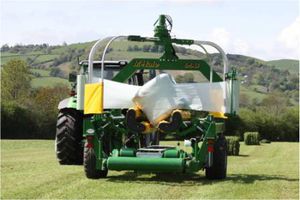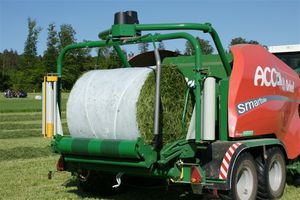

- Products
- Catalogs
- News & Trends
- Exhibitions
Silage sheeting F&Fbale wrapUV-resistantmultilayer

Add to favorites
Compare this product
fo_shop_gate_exact_title
Characteristics
- Application
- silage, bale wrap
- Other characteristics
- UV-resistant, multilayer, elastic
Description
Once combined, twice as good
The recent launch of combi-balewrappers capable of applying film instead of netwrap, such as the McHale Fusion 3 Plus, Krone Comprima and Orkel hiQ has paved the way for the adoption of Film&Film (F&F) Wrapping. The F&F Wrapping System is an innovative, dual film wrapping method comprising the combined use of SilotitePro next generation balewrap and Baletite, netwrap replacement film..
In addition to creating more compact bales that can better withstand handling, the F&F Wrapping System also helps to reduce silage losses through an enhanced oxygen barrier that discourages mould growth.
Whereas netwrap will continue to elongate post baling, the stiffer configuration of Baletite maintains the pressure that has been applied within the baling chamber and this greater crop compaction enables more efficient forage storage. Trials undertaken by ILVO (Instituut voor Landbouw – en Visserjonderzoek / Institute for Research in Agriculture and Fisheries) in Belgium found that F&F bales were on average 2cm smaller in circumference than traditional netwrapped bales in addition to being 10% denser.
The F&F Wrapping System can make the feed-out process easier too. If using a bale handler and mixer wagon it is possible to feed out the contents of F&F bales with minimum human intervention. The feeding process is also speeded up thanks to the easy removal of Baletite from the bale. Once opened, whether by hand or by bale handler, Baletite peels cleanly from the bale as no fodder can become enmeshed in it as with netwrap.
VIDEO
Catalogs
F&F
4 Pages
Exhibitions
Meet this supplier at the following exhibition(s):

Sommet de l'élevage 2025
7-10 Oct 2025 Clermont-Ferrand (France) Hall hall 1 - Stand F181
More information
*Prices are pre-tax. They exclude delivery charges and customs duties and do not include additional charges for installation or activation options. Prices are indicative only and may vary by country, with changes to the cost of raw materials and exchange rates.



